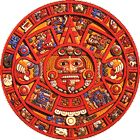Copyright © University of Cambridge. All rights reserved.
'Calendars' printed from https://nrich.maths.org/
Show menu
Calendars were one of the earliest calculating devices developed by civilizations. There have been many different calendars, but most are based on the sun, moon, seasons and often involve religious ideas.
The Mayans made an incredibly accurate calendar. The Mayan pyramid (Mexico) was built in about 1050 as a huge calendar. It has 91 steps up each side and one platform at the top, making a total of 365 (one for each day of the year).


The Mayan calendar was adopted by
the Aztecs, who kept the mathematics of the calendar the same, but
changed the names of the months.
We take our modern 'western' calendar for granted, but it has passed through a rather dramatic history, including the famous affair between Julius Caesar and Cleopatra, ard bloody war fought over dates! But it is not the only calendar. There are still forty different calendars in use around the world.
Why are there 53 weeks in some years, not 52?
Which day is the first day of the week, Sunday or Monday?
Where did the names for the days come from?
Why is a year 365 days?
The year 2000 was the Chinese Year of the Dragon. How does the Chinese calendar work?
